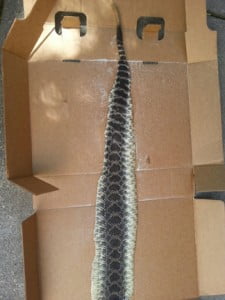Warm weather may mean pools, beaches and sunscreen, but Tim MacDonald was reminded that it’s also rattlesnake season.
MacDonald, who lives in Upper Briggs Terrace, was using a Havahart trap for ground squirrels when he caught a five-foot long rattler with an astounding 17 rattles.
He said that in 40 years, this snake was probably the longest one with the most rattles caught on his property and estimates that he has had in excess of 60 over the years.
It was the MacDonald family property that was visited – often – by Meatball the bear last summer before the bear was relocated to Lions, Tigers & Bears animal sanctuary in Alpine.
Snake Information from California Fish and Game Dept.
Rattlesnakes can cause serious injury to humans on rare occasions. The California Poison Control Center notes that rattlesnakes account for more than 800 bites each year with one to two deaths. Most bites occur between the months of April and October when snakes and humans are most active outdoors. About 25% of the bites are “dry,” meaning no venom was injected, but the bites still require medical treatment.
The potential of running into a rattlesnake should not deter anyone from venturing outdoors but there are several precautions that can be taken to lessen the chance of being bitten when out in snake country – which is just about anywhere in California.
Dos and don’ts in snake country
First, know that rattlesnakes are not confined to rural areas. They have been found near urban areas, in river or lakeside parks, and at golf courses. Be aware that startled rattlesnakes may not rattle before striking defensively. There are several safety measures that can be taken to reduce the likelihood of startling a rattlesnake.
- Never go barefoot or wear sandals when walking through wild areas. Wear hiking boots.
- When hiking, stick to well-used trails and wear over-the-ankle boots and loose-fitting long pants. Avoid tall grass, weeds and heavy underbrush where snakes may hide during the day.
- Do not step or put your hands where you cannot see, and avoid wandering around in the dark. Step ON logs and rocks, never over them, and be especially careful when climbing rocks or gathering firewood. Check out stumps or logs before sitting down, and shake out sleeping bags before use.
- Never grab “sticks” or “branches” while swimming in lakes and rivers. Rattlesnakes can swim.
- Be careful when stepping over the doorstep as well. Snakes like to crawl along the edge of buildings where they are protected on one side.
- Never hike alone. Always have someone with you who can assist in an emergency.
- Do not handle a freshly killed snake; it can still inject venom. Teach children early to respect snakes and to leave them alone. Children are naturally curious and will pick up snakes.

